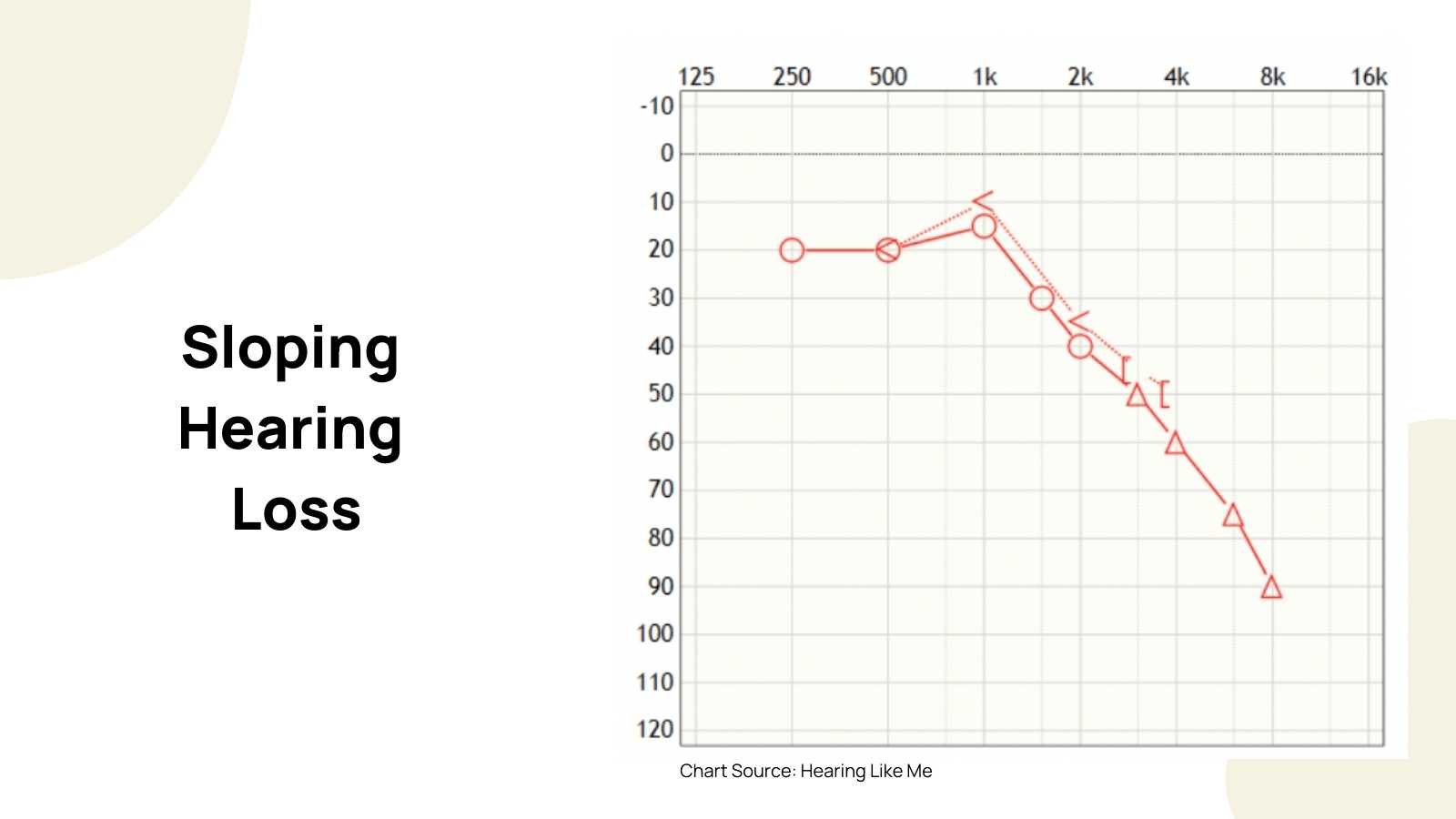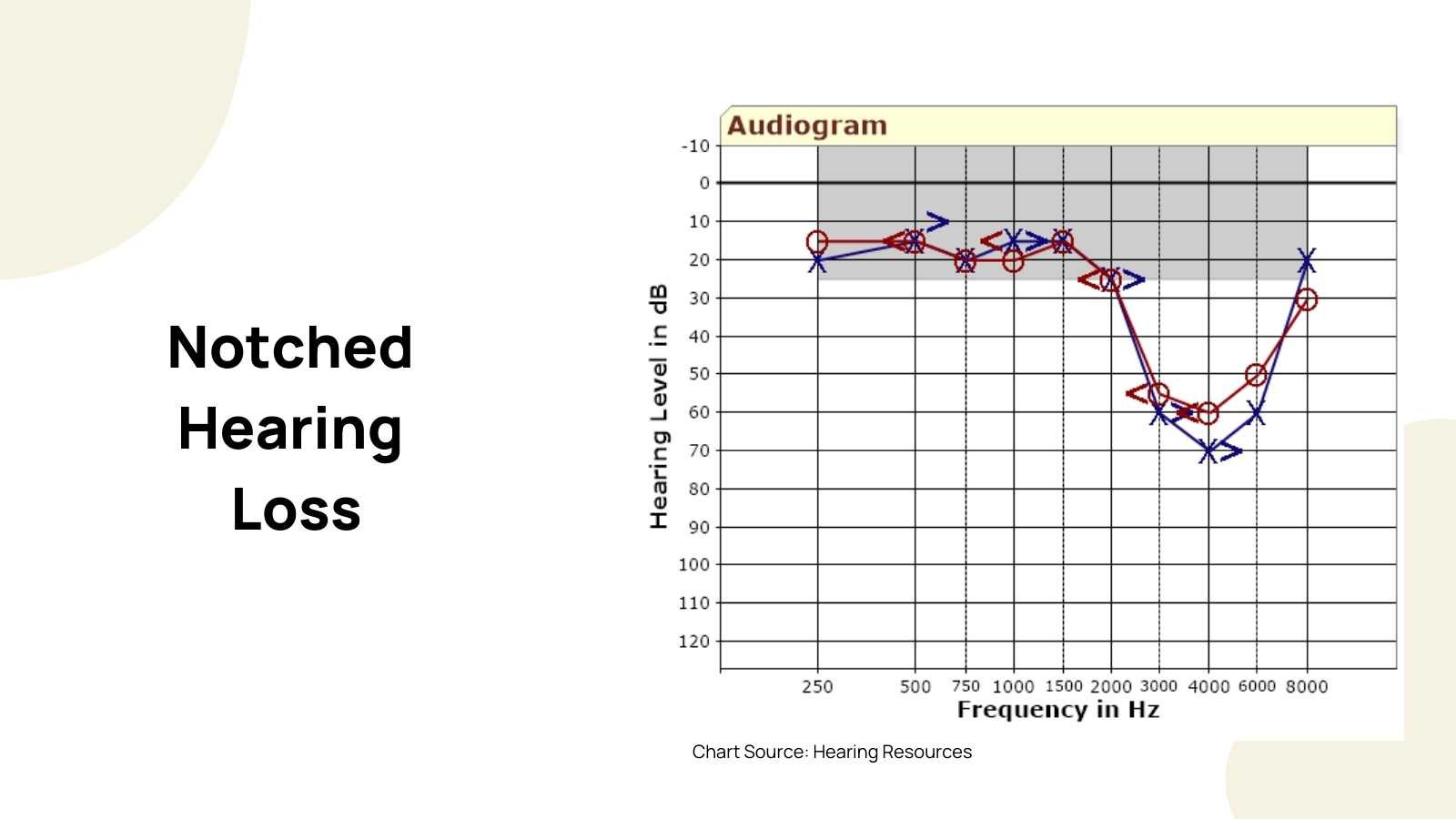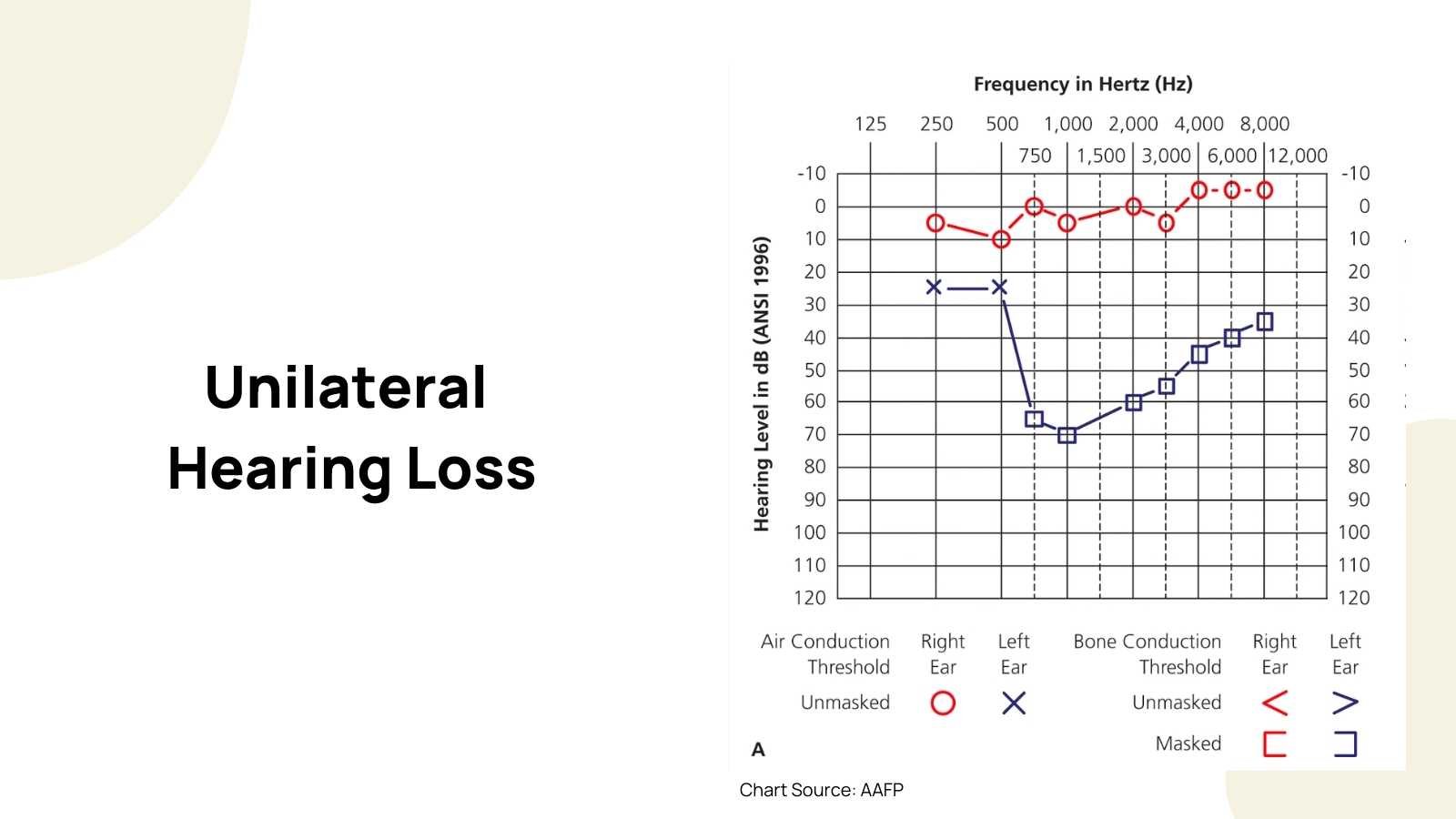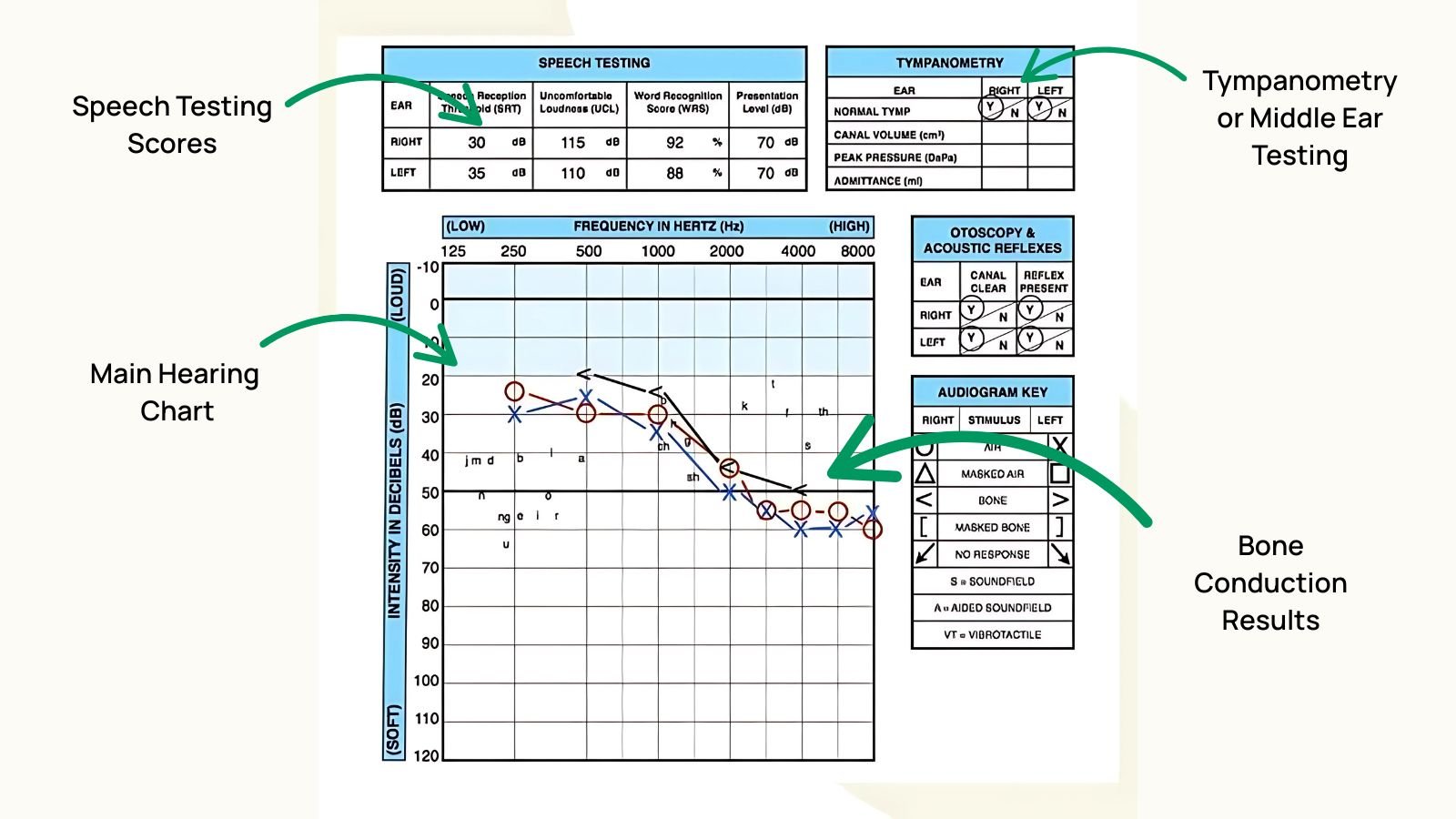Key Takeaways:
- Audiograms chart your hearing ability across pitches and volumes—normal hearing is between –10 and 20 dB HL.
- Mild to moderate hearing loss may qualify you for OTC hearing aids.
- Severe, asymmetrical, or complex hearing loss usually requires prescription hearing care.
- Not sure where you fit? Take Soundly’s free hearing test to get personalized guidance.

Understanding your hearing test results is crucial in managing your auditory health. An audiogram is the primary tool used to visualize these results, offering insights into your hearing capabilities across various frequencies and volumes.
This guide will help you interpret an audiogram, address common questions, and illustrate typical hearing loss patterns. Additionally, we'll focus on determining your suitability for over-the-counter (OTC) hearing aids.
Prefer to watch? Here's quick breakdown of how to read a hearing test from Soundly or a local clinic.

What Is an Audiogram?

An audiogram is a graph that plots your hearing thresholds—the softest sounds you can hear—across different frequencies. The x-axis represents frequency (pitch), measured in hertz (Hz), ranging from low to high pitches. The y-axis denotes intensity (loudness), measured in decibels hearing level (dB HL), from soft to loud sounds. Each point on the graph indicates the quietest sound you can detect at a specific frequency.
How to Read Your Audiogram
- Hearing Thresholds:
- Normal Hearing: -10 to 20 dB HL
- Mild Hearing Loss: 21 to 40 dB HL
- Moderate Hearing Loss: 41 to 55 dB HL
- Moderately Severe Hearing Loss: 56 to 70 dB HL
- Severe Hearing Loss: 71 to 90 dB HL
- Profound Hearing Loss: 91 dB HL and above
- Symbols: If you take a hearing test at a local clinic, you may see symbols on your audiogram. A red “O” typically represents the right ear, and a blue “X” represents the left ear—these mark your hearing thresholds. On Soundly’s hearing test, you'll see a blue dot for the left ear and an orange dot for the right ear instead.
The position of your thresholds on the graph indicates the degree and type of hearing loss. For instance, thresholds that dip in the high-frequency range suggest high-frequency hearing loss, which can affect the clarity of speech, especially consonant sounds.

Common Hearing Loss Configurations
Understanding the pattern of your hearing loss can aid in identifying its cause and determining appropriate interventions:
Sloping Hearing Loss
Better hearing at low frequencies, with a gradual decline at higher frequencies. Commonly associated with aging or noise exposure.

Notched Hearing Loss
A specific dip in hearing sensitivity, often around 3,000 to 6,000 Hz, typically resulting from noise-induced damage.

Reverse-Sloping Hearing Loss
Poorer hearing at low frequencies with better hearing at higher frequencies. This pattern may be linked to genetic conditions or certain medical disorders like Meniere's disease.

Cookie-Bite Hearing Loss:
Reduced hearing sensitivity in the mid-frequency range, with better hearing at low and high frequencies. Often hereditary and can impact the perception of speech nuances.

Unilateral Hearing Loss:
Hearing loss in one ear while the other ear has normal hearing. This can affect sound localization and understanding in noisy environments.

Asymmetric Hearing Loss
Hearing loss in both ears, but with one ear experiencing greater impairment. This condition requires thorough evaluation to determine the underlying cause.

Are You a Candidate for OTC Hearing Aids?
OTC hearing aids are designed for adults (18 and older) with perceived mild to moderate hearing loss. To assess if you're a suitable candidate:
- Degree of Hearing Loss: If your audiogram shows thresholds no worse than 60 dB HL across frequencies, OTC hearing aids may be appropriate. For thresholds exceeding this level, prescription hearing aids fitted by a professional are recommended.
- Configuration of Hearing Loss: OTC hearing aids are generally suitable for symmetrical hearing loss. If you have asymmetrical hearing loss, significant low-frequency loss, or other complex configurations, consult an audiologist for personalized recommendations.
- Medical Considerations: If you experience symptoms like sudden hearing loss, dizziness, pain, or tinnitus, seek medical evaluation before considering OTC options.
- Comfort with Technology: OTC hearing aids often require self-fitting and adjustments via smartphone apps. Ensure you're comfortable with this level of technology management.
Real-World Example Audiograms
The audiogram below shows a mild-to-moderate sloping hearing loss. Someone with this type of loss is typically a good candidate for either OTC or prescription hearing aids.
.jpg)
This audiogram shows moderate-to-severe sloping hearing loss. Individuals with this pattern typically benefit most from prescription hearing care.

Other Parts of An In-Clinic Audiogram To Know
If you’ve taken a hearing test at a clinic, you might receive a paper audiogram with more than just the charted hearing thresholds. Here’s what else you might see:
- Bone Conduction Results:
These are marked with brackets ([ ] or < >) and measure how well sound travels through the bones of your skull to your inner ear. Comparing air and bone conduction helps determine if your hearing loss is sensorineural, conductive, or mixed. - Speech Testing Scores:
You might see a number called the Speech Recognition Score (SRS) or Word Recognition Score (WRS)—this shows how clearly you understand words at a comfortable volume. It's a useful indicator of how well hearing aids might help. - Tympanometry or Middle Ear Testing:
Some audiograms include graphs or notes related to ear drum movement, checking for fluid behind the ear or pressure issues that might affect hearing. - Masking Symbols:
If there's a big difference between ears, your audiologist may use masking (a kind of noise in one ear to isolate the other). This is noted with extra symbols, like a triangle or square, to show the adjusted thresholds. - Audiologist Notes:
Many paper audiograms include a summary or interpretation—such as “mild sloping loss” or “recommend follow-up”—often handwritten or typed at the bottom.
These extra pieces help audiologists make a full diagnosis—not just of how much hearing loss you have, but what kind and what might help.

What Is Hidden Hearing Loss?
Hidden hearing loss occurs when someone struggles to hear in noisy environments, even though their audiogram appears normal. This condition is often caused by damage to the auditory nerve or synapses in the inner ear—parts of the hearing system not measured by standard hearing tests.
People with hidden hearing loss often say things like:
- “I hear fine in quiet places, but I can’t follow conversations in noise.”
- “My hearing test says I’m normal, but something still feels off.”
This kind of hearing difficulty can stem from:
- Noise exposure, even without obvious damage
- Aging-related neural changes
- Auditory processing challenges in the brain
If your hearing test looks normal but you’re still struggling, it’s worth discussing with a professional. While OTC hearing aids may help in some cases, many people with hidden hearing loss benefit from prescription hearing aids with specific programs to support speech-in-noise performance—or auditory training tools like LACE.
Final Thoughts
Understanding your hearing test is the first step toward better hearing. An audiogram reveals the sounds you’re missing and helps guide the best next steps—whether that’s exploring over-the-counter options or connecting with a professional for prescription care. If you're unsure, don’t worry—resources like Soundly are here to help you make sense of it all and find the right path forward.






